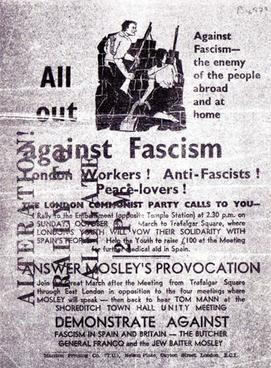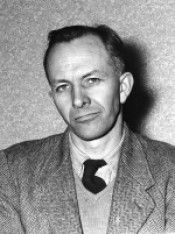Related Research Articles

Sir Oswald Ernald Mosley, 6th Baronet was a British aristocrat and politician who rose to fame during the 1920s and 1930s when, having become disillusioned with mainstream politics, he turned to fascism. He was a member of parliament and later founded and led the British Union of Fascists (BUF).

The Battle of Cable Street was a series of clashes that took place at several locations in the East End of London, most notably Cable Street, on Sunday 4 October 1936. It was a clash between the Metropolitan Police, sent to protect a march by members of the British Union of Fascists led by Sir Oswald Mosley, and various anti-fascist demonstrators including local trade unionists, communists, anarchists, British Jews, and socialist groups. The anti-fascist counter-demonstration included both organised and unaffiliated participants.

The British Union of Fascists (BUF) was a British fascist political party formed in 1932 by Oswald Mosley. Mosley changed its name to the British Union of Fascists and National Socialists in 1936 and, in 1937, to the British Union. In 1939, following the start of the Second World War, the party was proscribed by the British government and in 1940 it was disbanded.
The 43 Group was a British anti-fascist group set up by Jewish ex-servicemen after the Second World War. They did this when, upon returning to London, they encountered British fascist organisations such as Jeffrey Hamm's British League of Ex-Servicemen and later Oswald Mosley's new fascist party, the Union Movement. The activities of these fascist groups included antisemitic speeches in public places, and from the rank-and-file fascists, violent attacks on London Jews and Jewish property. Group members broke up far-right meetings, infiltrated fascist groups, and attacked the fascists in street fighting.
The Canadian Union of Fascists was a fascist political party based in the city of Toronto in the 1930s with its western Canadian office in Regina, Saskatchewan.

Rotha Beryl Lintorn Lintorn-Orman was the founder of the British Fascisti, the first avowedly fascist movement to appear in British politics.

Edward Jeffrey Hamm was a leading British fascist and supporter of Oswald Mosley. Although a minor figure in Mosley's prewar British Union of Fascists, Hamm became a leading figure after the Second World War and eventually succeeded as leader of the Union Movement after Mosley's retirement.
Thomas P. Moran was a leading member of the British Union of Fascists and a close associate of Oswald Mosley. Initially a miner, Moran later became a qualified engineer. He joined the Royal Air Force at 17 and later served in the Royal Naval Reserve as an engine room artificer.
The 1940 Middleton and Prestwich by-election was held for the Middleton and Prestwich constituency on 22 May 1940, after the death of the sitting MP, Nairne Sandeman. It was held during World War II, and five of the largest political parties – Conservative, Labour, Liberal, National Labour and National Liberal agreed to an electoral pact not to contest any by-elections in seats held by any of the other parties.
Robert Forgan was a British politician who was a close associate of Oswald Mosley.
British fascism is the form of fascism which is promoted by some political parties and movements in the United Kingdom. It is based on British ultranationalism and imperialism and had aspects of Italian fascism and Nazism both before and after World War II.

The Union Movement (UM) was a far-right political party founded in the United Kingdom by Oswald Mosley. Before the Second World War, Mosley's British Union of Fascists (BUF) had wanted to concentrate trade within the British Empire, but the Union Movement attempted to stress the importance of developing a European nationalism, rather than a narrower country-based nationalism. That has caused the UM to be characterised as an attempt by Mosley to start again in his political life by embracing more democratic and international policies than those with which he had previously been associated. The UM has been described as post-fascist by former members such as Robert Edwards, the founder of the pro-Mosley European Action, a British pressure group and monthly newspaper.
Neil Lanfear Maclean Francis Hawkins was a British writer and politician who was a leading proponent of British fascism in the United Kingdom both before and after the Second World War. He played a leading role in the British Union of Fascists and controlled the organisational structure of the movement.

The Battle of Stockton, took place on 10 September 1933 at the Market Cross in the High Street of Stockton-on-Tees, County Durham, England. It was a clash between members of the British Union of Fascists (BUF) and anti-fascist demonstrators from the small local Communist Party and National Unemployed Workers Movement (NUWM).

Robert Row (1915–1999) was an English fascist from Lancaster, a member of Oswald Mosley's British Union of Fascists (BUF) who was detained by the British government under Defence Regulation 18B during the Second World War. After the war, he wrote and edited British fascist publications and remained a believer in Mosley until his death.

John Warburton was an English fascist and press photographer. He was an assistant district leader for the Clapham branch of Sir Oswald Mosley's British Union of Fascists (BUF) before the Second World War, and afterwards was a key member of the Union Movement, the founder editor of Comrade, and the senior Council member of Friends of Oswald Mosley.
The Battle of South Street was a riot that took place on 9 October 1934 in Worthing, Sussex, England. The riot took place as members of the British Union of Fascists and various anti-fascist protesters clashed following a meeting of Fascists at the Pier Pavilion. The riot involved a series of clashes along and close to the length of South Street from the Pier Pavilion and the Royal Arcade at its southern end to the junctions with Warwick Street and Market Street further north.

Charles Frederick Watts was a member of the British Union of Fascists who was interned during the Second World War.
The Battle of De Winton Field was a clash between the British Union of Fascists and various anti-fascist demonstrators that took place in Tonypandy, Wales, on 11 June 1936. It was the BUF's last attempt to hold a rally in Wales.
The Battle of Carfax (1936) was a violent skirmish in the city of Oxford between the British Union of Fascists (BUF) and local anti-fascists, trade unionists, and supporters of the Labour Party and the Communist Party of Great Britain. The battle took place inside Oxford's Carfax Assembly Rooms, a once popular meeting hall owned by Oxford City Council which was used for public events and located on Cornmarket Street.
References
- ↑ Libraries, Leeds (June 14, 2019). "Oswald Mosley and Leeds – The Battle of Holbeck Moor 27th September 1936".
- ↑ "Peaky Blinders' fascist villain Oswald Mosley tried to spread far-right message in Leeds - but the city taught him a lesson". www.yorkshirepost.co.uk.
- ↑ Bergen, Amanda (March 29, 2019). The unwalled ghetto: Mobility and anti-Semitism in the interwar period. Manchester University Press. ISBN 9781526123091 – via www.manchesterhive.com.
- ↑ "The dark day fascists marched in Leeds". www.yorkshirepost.co.uk.
- ↑ "Remembering the Battle of Holbeck Moor". tribunemag.co.uk.
- ↑ "John Mann: 30,000 people stood up to the Blackshirts on Holbeck Moor, we need to learn from that". www.yorkshireeveningpost.co.uk.
- ↑ "1930s fascism inspires Tracy-Ann Oberman's Shylock". March 12, 2020.
- ↑ "Reference at www.thejc.com".